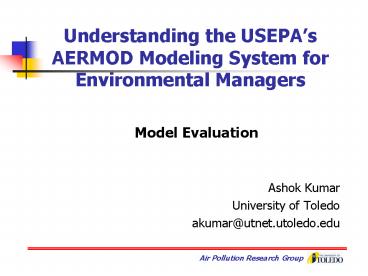Understanding the USEPA - PowerPoint PPT Presentation
1 / 31
Title:
Understanding the USEPA
Description:
Understanding the USEPA s AERMOD Modeling System for Environmental Managers Model Evaluation Ashok Kumar University of Toledo akumar_at_utnet.utoledo.edu – PowerPoint PPT presentation
Number of Views:106
Avg rating:3.0/5.0
Title: Understanding the USEPA
1
Understanding the USEPAs AERMOD Modeling System
for Environmental Managers
Model Evaluation
- Ashok Kumar
- University of Toledo
- akumar_at_utnet.utoledo.edu
2
Evaluation Studies on AERMOD
- USEPA
- Evaluation using field studies
- No evaluation using ambient air monitoring
network in an urban area
3
Lucas County Sources and Monitoring Stations
4
Input Data Flow in AERMOD
5
Data Requirements for Model Evaluation
- Emission Inventory
- Properties of stacks and super stacks
- Meteorological data
- Receptor data
- Air monitoring data
6
AERMET - Input
- Meteorological Input Parameters Multi-Level WS,
WD, and Temperature, Opaque Cloud Cover, Ceiling
Height, RH, Pressure, Surface Heat Flux,
Friction Velocity, and Roughness Length, Delta-T
, Solar Radiation, Upper Air Data - Data Formats - CD144, SCRAM, SAMPSON (surface
data) - TD 3280 (surface data )
- TD6201 (upper air data)
- On-site (site specific data)
7
AERMET - Output
- Boundary Layer File
- sensible heat flux
- surface friction velocity
- convective velocity scale
- potential temp. gradient above mixing height
- convectively-driven mixing height
- mechanically-driven mixing height
- Monin-Obukhov length
- surface roughness length
- Bowen ratio
- albedo
- Profile File
- Measurement height
- WD, WS
- Temperature
- Standard Dev. of Lateral WD
- Standard Dev. of Vertical WS
8
Atmospheric Stability
- AERMOD uses Monin-Obukhov length as the stability
parameter - You will need friction velocity uand the flux of
sensible heat H to compute L - L is defined to be negative in convective
conditions and positive in stable
9
AERMAP
- Input data needs for AERMAP
- DEM formatted terrain data
- User provided receptors and terrain
- Design of receptor grid AERMAP accepts either
polar, cartesian or discrete receptors
10
Pathways Used in AERMOD Input Runstream
- Control
- Source
- Receptor
- Meteorology
- Output
11
Statistical Evaluation Methods
- Fractional Bias (FB)
- Normalized Mean Square Error (NMSE)
12
Statistical Evaluation Methods
- Coefficient of Correlation (COR)
- Factor of Two (Fa2)
- Fraction of data for which 0.5ltCp/Colt2
13
Statistical Evaluation Methods
- Confidence Limits
- Confidence limits are the lower and upper
boundaries / values of a confidence interval,
that is, the values which define the range of a
confidence interval. The upper and lower bounds
of a 95 confidence interval are the 95
confidence limits. - Q-Q Plots
- The quantile-quantile (Q-Q) plot is a graphical
technique for determining if two data sets come
from populations with a common distribution.
14
Results Discussion
- Model is evaluated in the following ways
- Performance measures and confidence limits for
- 3-hr average for SO2
- Stable Condition
- Convective Condition
- 24-hr average for SO2
- Plots of NMSE vs.FB
- Q-Q plots for 3-hr average for S02
- Q-Q plots for 24-hr average for S02
15
NMSE vs FB plots (3-hr average)
16
NMSE vs. FB plots(3-hr average)
17
NMSE vs. FB plots (3-hr average)
18
NMSE vs. FB plots (3-hr average)
19
NMSE vs. FB plots (24-hr average)
20
Q-Q plots (3-hr average)
21
Q-Q plots (3-hr average)
22
Q-Q plots (3-hr average)
23
Q-Q plots (3-hr average)
24
Q-Q plots (3-hr average)
- Observed Concentrations lt 20µg/m3
25
Q-Q plots (3-hr average)
- Observed Concentrations lt 20µg/m3
26
Q-Q plots (3-hr average)
- Observed Concentrations lt 20µg/m3
27
Q-Q plots (3-hr average)
- Observed Concentrations lt 20µg/m3
28
Q-Q plots (24-hr average)
29
Q-Q plots (24-hr average)
30
Confidence Limits (3-hr average)
- The values of NMSE and FB were significantly
different from zero in the stable case. COR was
not significantly different from zero. - The values of NMSE, FB, and COR were not
significantly different from zero for the
convective case.
31
Confidence Limits (24-hr average)
- The values of NMSE and FB were significantly
different from zero. COR, was not significantly
different from zero. - Note 24-hr data were not divided according to
stability classes.






























